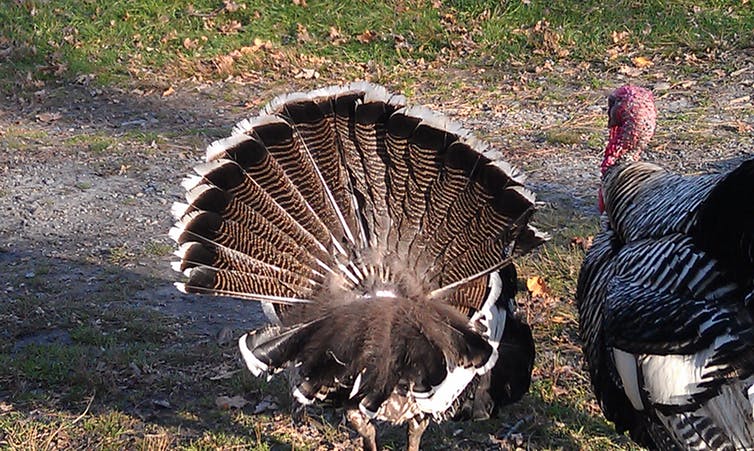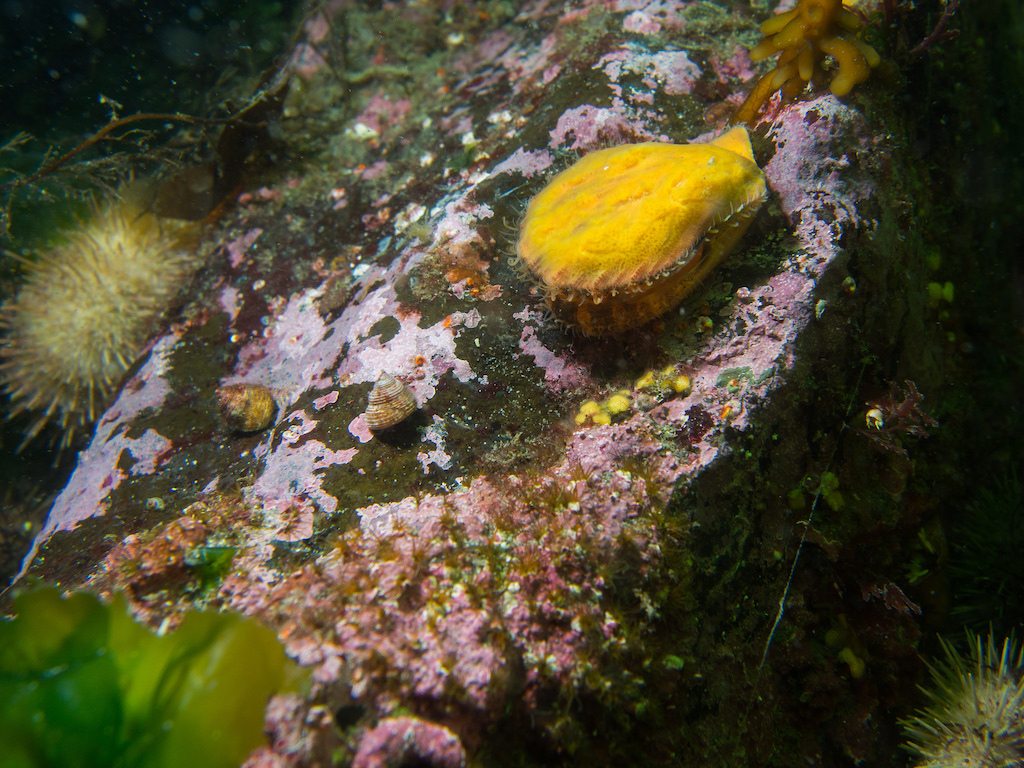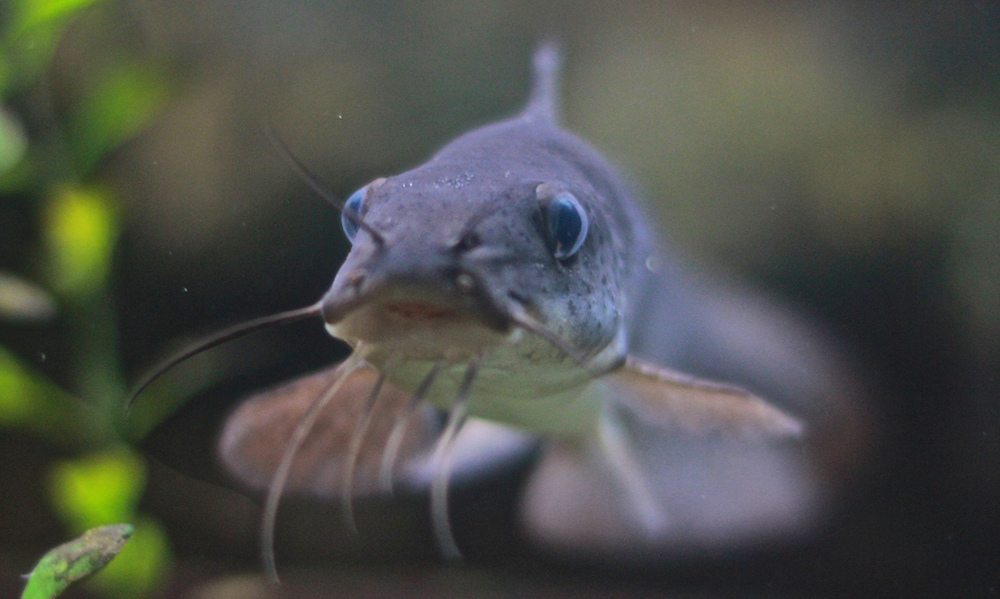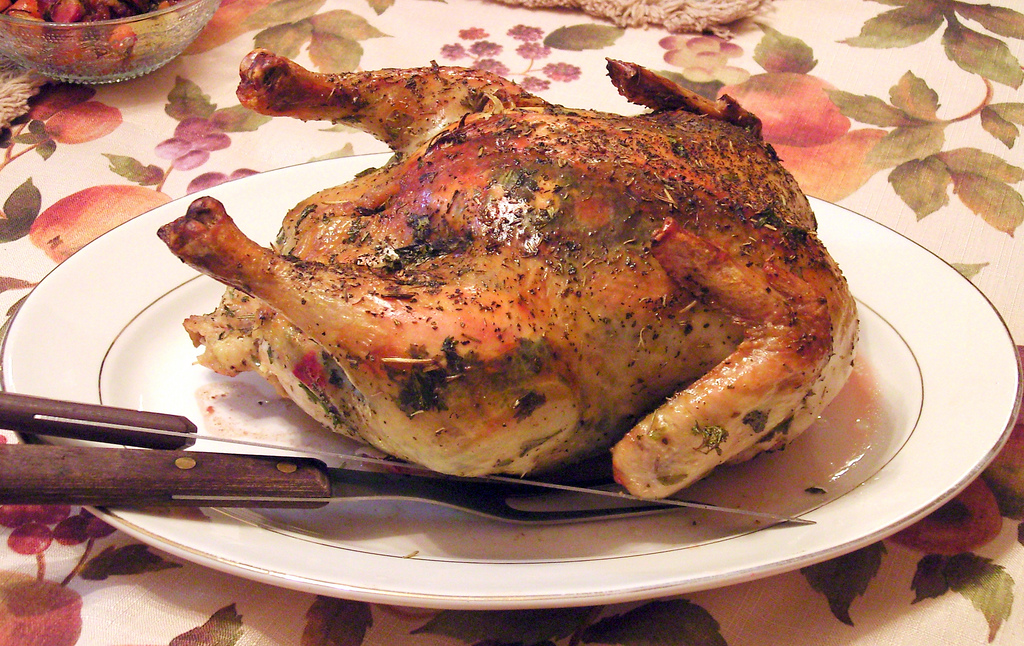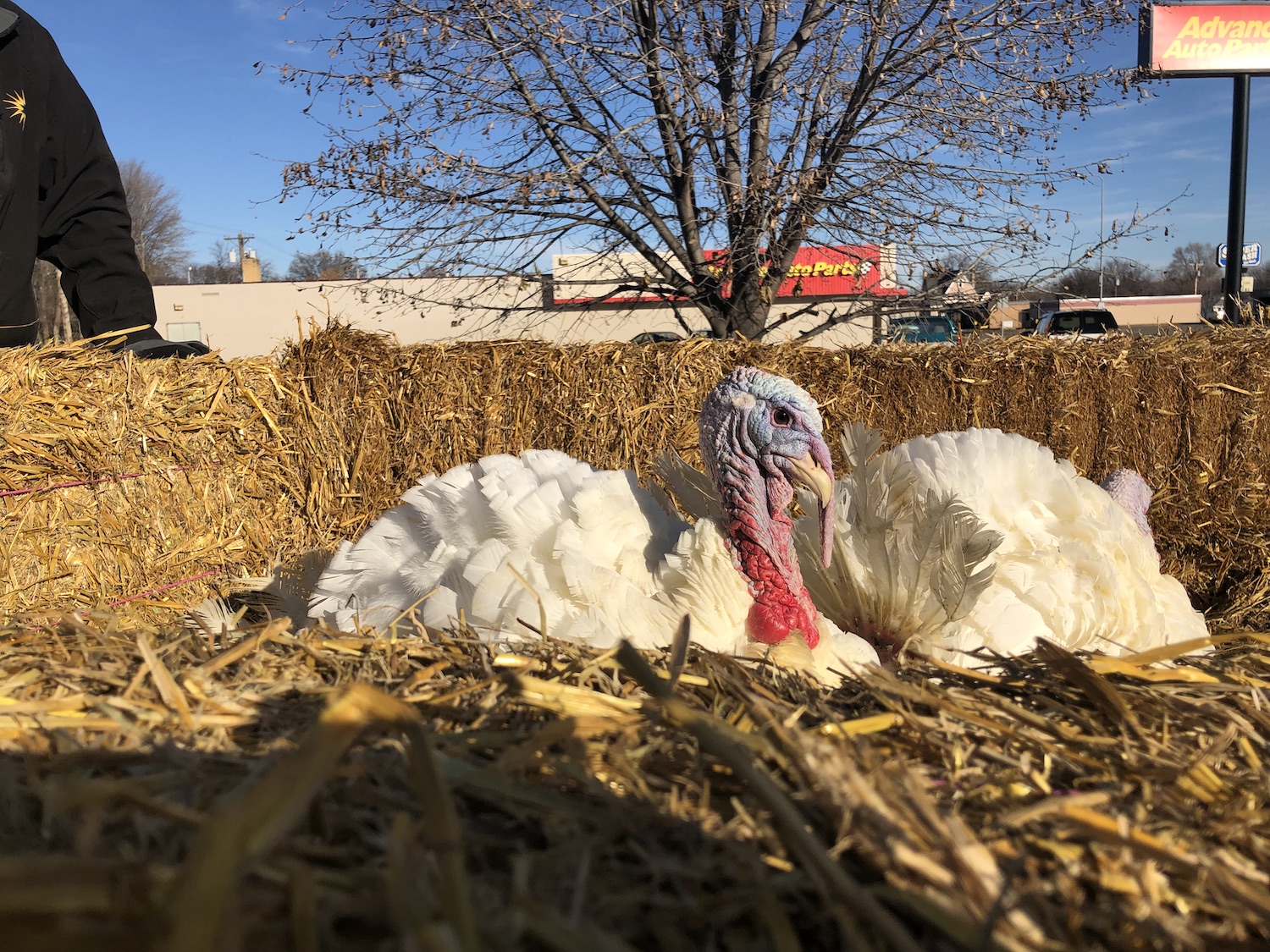
South Dakota Tourism
In July, a Hutterite colony in South Dakota hatched a special flock of 50 turkeys. In some ways, they were raised like any of the other 46 million birds that wind up on Thanksgiving tables across America every year—inside a barn, “free to strut about with constant access to water and a feed mix of corn and soybeans”—according to a fact sheet from the National Turkey Federation.
But these birds were also special. They were contenders for Presidential Turkey Pardon. From the time they were chicks, they had practiced for a stately moment: standing on a table, exposed to bright lights and the sounds of a crowd, even to the music of Kenny Chesney one year. As the days crept closer to the Thanksgiving showdown, the finalists visited families and children throughout Huron, South Dakota, a city of 13,000 known for its statue of the “world’s largest pheasant,” standing guard over a stretch of highway.
 Dakota Provisions
Dakota Provisions Children meet the two lucky turkeys who will be graced with a Presidential Turkey Pardon this Thanksgiving
It’s unclear how exactly the birds are whittled down from a total of 50—what the rules are in poultry’s biggest sudden death tournament—but somehow, through all these trials, 50 becomes 20 becomes 10 becomes two. Two turkeys that, in the past, have ridden to the airport in a presidential-style motorcade, complete with security from fake Secret Service agents. Their names are a national secret until just before the big ceremony.
On Sunday, the two lucky birds, which for many years have been Broad Breasted Whites—a commercial variety bred to produce an overabundance of white breast meat—were flown on “Turkey One” from their home state to Washington, D.C. They will be hosted in style as guests of the Willard InterContinental, a luxury hotel that has hosted the turkeys for at least a decade. “They don’t sleep on the bed,” says Janet Scanlon, the hotel’s senior marketing manager, “the turkey federation does an amazing job of, I know it’s not a real word, but ‘turkifying’ the room.” Wood shavings are spread over the floor, and a long plastic tarp is hung to protect the walls from poultry emissions.
Their schedules are so full during their time in D.C. that guests at the hotel may never see the birds. Yet, Scanlon adds, if you’re on the right floor you can hear them “from time to time.” She occasionally talks to the birds (“like when you go up to a dog”) and they talk back to her with their throaty gobbles. Scanlon says she’s learned a lot about turkeys since coming to the InterContinental—they like sitting in laps and being pet—and they’re much larger than she expected.
 White House
White House Wishbone and Drumstick, 2016 recipients of the Presidential Turkey Pardon, enjoyed a stay at the Willard InterContinental luxury hotel in Washington, D.C.
All this pomp and circumstance is just the lead-up to what has become a strangely beloved institution. Though the National Turkey Federation has been presenting an annual turkey to the president since 1947, the White House Historical Association notes that “presentation turkeys” were eventually given a different placement than on the White House’s Thanksgiving dinner table beginning in 1981, under then-President Ronald Reagan. In 1989, when George H.W. Bush was in office, the event was regularly being picketed by animal rights activists, which prompted him to quip that the turkey was “granted a Presidential pardon as of right now.”
A tradition was born.
After their shining moment, pardoned turkeys have been sent all kinds of places, from farms and petting zoos, to George Washington’s Mount Vernon, and even to Disneyland, where they served as grand marshals of the Thanksgiving Day Parade for five years. Thanks to their genetics, which allow them to gain increasing amounts of weight on less feed, these turkeys can’t fly (except on a plane), can’t reproduce naturally, and—if they’re left to their full lifespans—can have skeletal deformities as a result of supporting so much weight on a frame that wasn’t meant to sustain it. Commercial turkeys are typically slaughtered between 14 and 18 weeks of age, and weigh just over 30 pounds on average, according to the United States Department of Agriculture (USDA); their wild cousins weigh half that. Tater and Tot, pardoned by President Obama in 2016, both weighed roughly 40 pounds at the time of their absolution.
 Obama White House archives / Pete Souza
Obama White House archives / Pete Souza Tot, during President Barack Obama’s final turkey pardoning ceremony. Tot’s partner, Tater, died in September of 2017
The turkey pardon often feels like a welcome reprieve from the partisanship we’ve come to expect from politics. Last year, President Trump remarked during the ceremony, “I’m pleased to report that, unlike millions of other turkeys at this time of the year, Drumstick has a very, very bright future ahead of him.” But jokes about the turkeys heading for a long retirement or lounging on the beach are just that, of course, jokes that don’t reflect the lives the birds actually lead once the cameras look away. Drumstick and his back-up, Wishbone, might have had a bright future at “Gobbler’s Rest,” cared for by Virginia Tech’s department of animal and poultry sciences, where they joined Obama pardons Tater and Tot, but it wasn’t a long one. Drumstick died in January; Wishbone in June. Tater died in September, likely just a few months after his second birthday. It was a feat of the natural world when Courage, pardoned by Obama in 2009, lived over six years.
“They have to be on a restricted diet because of the way that they’re built,” says Susie Coston, shelter director at Farm Sanctuary in Watkins Glen, New York. She says that the birds will eat themselves to death otherwise. “A heritage turkey will eat what it needs and that’s it. [The Broad Breasted White] will eat until the food is gone. We had a male come in that weighed 80 pounds—that’s the size of a small goat.”
Farm Sanctuary has tried to convince the White House to send pardoned turkeys its way, on and off, for many years. “Raising them for longevity is very different from fattening them for food,” Coston says. The pardon, she says, might be meaningful for those two turkeys, “But think of how much better it would be if you sent them to a place where it’s known they’d have a long and happy life.” She adds, “We would treat them like the kings and queens they are.”
“Ironically, [the pardon] probably did become popular with the public because people love animals,” says Ashley Byrne, an associate director at PETA. Though the number of Americans who identify as vegan or vegetarian hasn’t grown significantly over the past 20 years, people are eating less meat, adopting flexitarian diets, and are increasingly concerned about animal welfare. Because of this, Byrne believes that if the Turkey Federation had it to do over again, it might not have created a tradition that raises the question of what we’re pardoning animals for in the first place. “I think people would be much less inclined to see it as a happy occasion knowing that the average meat-industry bred turkey is going to live a short, sickly painful life,” she says. The turkey presentation, which is sponsored by the National Turkey Federation, is meant to help keep turkey in the American diet. But eating turkeys and wanting those that are spared the fork to have the best and longest possible lives shouldn’t be mutually exclusive goals.
 South Dakota Tourism
South Dakota Tourism “Poultry like to have a friend,” says David Linker, Virginia Tech’s animal and poultry science farm manager
The turkey pardon is the kind of tradition that can only remain beloved if you don’t look at it too closely. Many people have made the point that, even if it appears to be one of the few remaining non-partisan events in Washington, it’s actually a bit of cruelty aimed at the many prisoners sitting on death row, hoping that a presidential pardon might spare their lives. Philosopher Justin H.E. Smith wrote of the pardon in The New York Times, “There is in it an implicit acknowledgment that the killing of these prisoners is a practice that bears real, non-jocular comparison to the ritual slaughter of birds for feasts.”
While most presidents keep politics at a remove from their turkey presentation speech, last year, President Trump used the opportunity to joke about his penchant for reversing “a number of executive actions by my predecessor.” Though his lawyers, he remarked, had informed him that “Tater and Tot’s pardons cannot, under any circumstances, be revoked.”
We don’t take the turkey pardon seriously, but we could. As Obama said in 2014, “It’s a little puzzling that I do this every year.” What if, instead of dad jokes and an off-color mockery of the ritual (possibly one of the most powerful tools at the Executive Branch’s disposal) we instead turned it into an actual turkey thanks-giving, sparing two birds in honor of the millions who do end up on our tables?
This week, two as-yet-unnamed birds will embark on their D.C. odyssey, heirs to the same spectacle as so many birds before them. They will then will travel to Virginia Tech to live out their remaining days in a pie-shaped stall with a plexiglass partition and heater, positioned in the side of a livestock arena. They’ll be put on a low-carb diet but continue to grow anyway, says David Linker, Virginia Tech’s animal and poultry science farm manager: “After a while, it’s difficult for them to carry themselves around.” The birds will have visits multiple times a week from veterinarians who take their temperature, trim their toenails, and check for early signs of conditions like heart failure that might further shorten their already short lives.
 South Dakota Tourism
South Dakota Tourism Through a mysterious vetting process, 50 turkeys becomes 20 becomes 10 becomes two. Their names will be announced at 11 a.m., EST on Monday
“I’ve learned a lot of things about turkeys by having them as my neighbors,” Linker says. He adds that the birds like to make their presence known. “Every time you walk in the door and it squeaks, the turkeys will gobble. They’re loud. If I play music in my office they start making noise and it’s just not worth it.” Linker has been enjoying the silence these last few months since Tater died, and admits that, while students and guests still get excited to meet the presidential turkeys, he’s “a little over it, if you want to know the truth.” One beef cattle professor who teaches in the livestock arena used to like to let the turkeys out, Linker says, so it’d just be him and two turkeys “standing there and teaching class.”
Though the turkeys are pardoned two-by-two, the real reason for that number might have less to do with the necessity of a backup than the fact that turkeys get lonely. “Poultry like to have a friend,” Linker says, though the birds aren’t so social that you can stick a bunch of strangers in a pen and hope they get along. President Obama’s turkeys were in one partition and President Trump’s in another until Tot (D-IA) and Drumstick (R-MN) died, leaving Tater (D-IA) and Wishbone (R-MN) close by but ultimately alone. “We tried to put them together and they couldn’t stop fighting,” Linker says. So they were separated again, just one partition away from each other.
When the last birds died, they did so alone in their pens, gobbling like watchdogs at anyone who walked in the front door.




